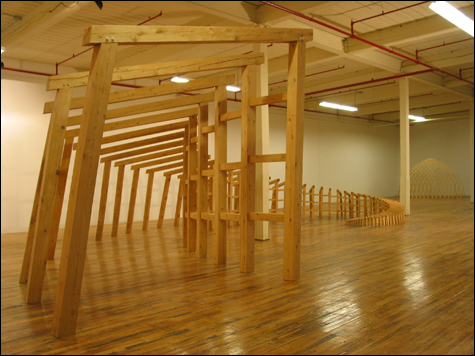
|
| "Castle" | Wood sculptures by Ben Butler | At Coleman Burke Gallery, Fort Andross, 14 Maine St, Brunswick | Through September 8 |
The sheer size of the Coleman Burke Gallery, located in Brunswick’s Fort Andross building, proves to be a playground for the ambitious scope of Ben Butler’s warm, minimalist sculptures. The Chicago-based artist and Bowdoin College graduate exhibits three pieces exemplifying repetitive natural geometries and composed of natural, bare wood that resonates with the hardwood floors of the gallery. The sculpture that comprises the “Castle” exhibit explores the rare opportunity to work indoors on a large scale with plenty of elbow room left over so the viewer can fully explore every angle.At first, the show feels perhaps too spacious. Butler’s work sits so naturally in the room, the viewer may be tempted to respond with a defensive, “Is that it?”, a question that continues to baffle the uninitiated or unconvinced on the cubes and stripes of 1970s minimalism.
Butler, however, has a bright-eyed fascination with mathematical systems and a humble construction aesthetic worthy of the Shakers. What could be industrial metal is warm wood. What could be a monolith is a system-made-visible, transparent enough to invite the viewer to explore every angle. The sculpture feels comforting because it is derived from the same unseen mathematical relationships informing our natural world, yet the work also pushes us to contemplate those systems towards a sometimes uncomfortable and confounding esoteric territory.
“Nest” is a web of glued poplar pieces fashioned into self-supporting arches. Ten or so layers of the same structure rest tentatively atop one another like Russian dolls. Depending on which angle you look from, the piece is reminiscent of an upturned hull of a boat, or an elaborate arched tunnel. Everywhere your eye meets the work, a passage or tunnel opens up and barrels toward an infinity suggested by these separate, skeletal structures. Your eyes do the work filling in the gaps of these simple relationships to create a sense of movement through abstracted space.
Up-close scrutiny of “Chamber” is not as successful an experience as that of “Nest.” Simply crafted pine quadrilaterals are shaped and stacked on a bed of similarly constructed triangles pointing up like stalagmites. One piece set atop another like children’s blocks creates a rough-hewn arch, each side forming a supportive grid. The open shapes are momentarily enjoyable to look through but the visual play is confused by the casual manner in which each block is freely balanced. They don’t form a smooth surface and you don’t know quite what to take from the structure.
Ten paces backwards, however, and at just the right angle, a little optical magic helps the piece pay off. The positive and negative spaces crystallize to form a tight geometric arch, budding like a clover flower. Suddenly, the piece has moved from confusing craft to an almost glowing auric example of a growth pattern.
“All things long to persist in their being” meditates on space and time by sequencing hefty hemlock joined together into structures like a door frame or an arbor but with an ancient resonance reminiscent of the Stonehenge monuments. As the repetitive shapes move along a spiral path, they change scale from ten feet high to smaller than a domino. Your own movement alongside this spiral path is a crucial interaction in interpreting the piece. The spare constructions allow for negative space that reveals the distant iterations further along the path. Your choice of vantage point is a constantly changing parameter within this fixed mathematical relationship. The scale shifts, but the ratio remains and inches can become miles, seconds spent walking can be interpreted as years. The viewer is connected to a cosmic constant that dictates the shape of our world from seashells to galaxies.
The algorithmic nature of the piece invites comparison to Robert Smithson’s “Spiral Jetty,” a land-based exploration of natural geometries and recontextualization of the temporal in art. If Smithson is the cool science teacher who took your class outside on a field trip, then Butler is the cool science teacher that let you build models rather than scribble equations on the chalkboard. “Castle” feels at home within the gallery walls because the sculptures act as didactic springboards for an awareness inculcated with the spiritual drive of science and inspired by the joyful craft of artistic creation.
Email the author
Ian Paige can be reached at ianpaige@gmail.com
Coleman Burke Gallery: mwethli@bowdoin.edu